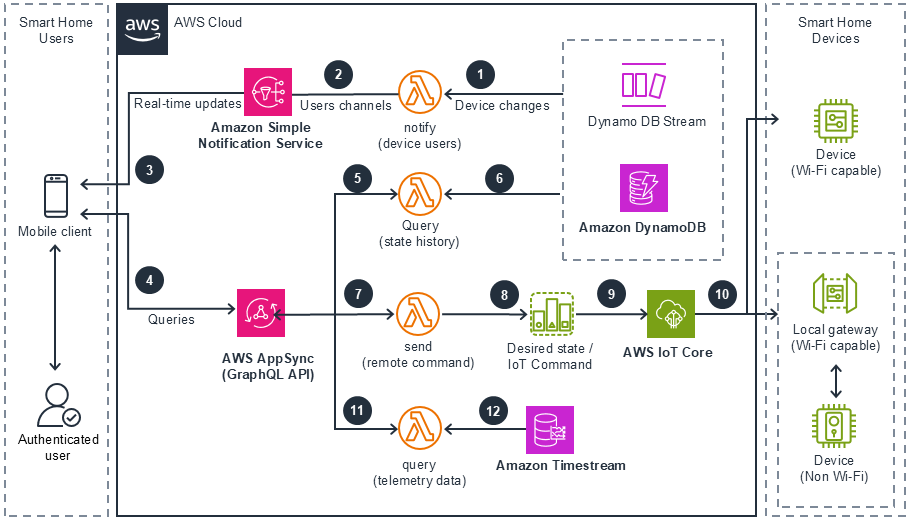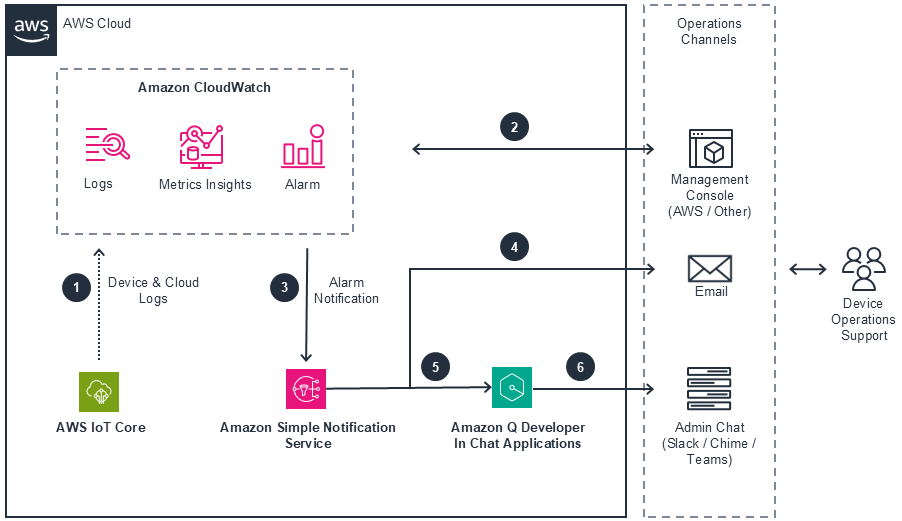- AWS Solutions Library›
- Guidance for Building Smart Home Solutions on AWS IoT
Guidance for Building Smart Home Solutions on AWS IoT
Building Secure, Scalable, and Intelligent Smart Home Solutions on AWS
Overview
This AWS IoT Solution Guidance shows device makers (OEMs) and
IoT developers how to design and deploy production-ready smart home platforms that deliver seamless, secure, and differentiated end-user and consumer experiences. The guidance outlines proven architectural patterns for the end-to-end smart home lifecycle, from device onboarding and data ingestion to fleet management, real-time monitoring, and over-the-air (OTA) updates. It explains how to implement secure command and control, manage device fleets at scale, and ensure user privacy through robust identity and access controls. It also details how to establish a data Lakehouse foundation that unlocks long-term business value; powering analytics, AI/ML personalization, predictive maintenance services, and self-service diagnostics and support for users. By following these AWS-validated best practices, OEMs can accelerate development, reduce operational complexity, and launch smart home solutions that are resilient, secure, future-proof, and ready to scale globally.
Benefits
Bring new features to market faster with a cloud foundation that scales securely as your business grows globally, in volume or more diverse in product portfolio. Deploying on a managed IoT platform simplifies device connectivity, data management, and operations, freeing your teams to focus on your end customer experience instead of infrastructure. Streamlined data flows and real-time insights reduce time-to value, while built-in scalability and reliability turn innovation into a repeatable process. With AWS as the backbone, you can move from concept to customer impact in weeks, not months.
Harness device telemetry and user interaction data through integrated analytics services. Transform every connected device into a continuous feedback engine. By capturing and analyzing real-time telemetry, user interactions, and performance data, gain a clear view of how products behave in the field and how customers truly use them. A unified data Lakehouse and integrated AI/analytics services convert raw signals into precise, actionable intelligence, revealing emerging issues before they become problems, uncovering hidden usage patterns, and identifying the features that drive engagement. These insights fuel faster iteration, smarter product decisions, and proactive support experiences that build trust and loyalty. Every device event becomes an opportunity to innovate, optimize, and strengthen your customer relationship.
Streamline and automate connectivity, secure provisioning, and configuration with workflows built to manage millions of devices globally. Ensure continuous, resilient connectivity, from onboarding to decommissioning, so every device stays secure, operational, and connected throughout its entire lifecycle.
Transform device data into intelligence with integrated AI/ML pipelines, predict issues before they occur, personalize user experiences, and automate device recovery through real-time insights. AI-powered self-service support, fueled by telemetry and natural language interaction, enables users to diagnose and resolve issues instantly, reducing ticket volume and service costs. With this foundation, every product becomes more reliable, every customer experiences more intuitive, and every support interaction a chance to learn and improve.
Every connected device is a source of continuous customer and product insight. When data from millions of homes flows securely into a unified AWS IoT and analytics architecture, it adds to operational visibility and becomes a foundation for measurable business outcomes. A centralized data Lakehouse built on AWS (S3, Glue, Athena, Redshift, QuickSight, SageMaker) makes data accessible and actionable across the organization. It can be used to deliver on Product Innovation and Quality Improvement, Customer Experience and Retention, Operational Efficiency and Cost Reduction, event ally leading to New Revenues and Service Models.
How it works
Data Ingestion
Smart Home devices generate various types of data (telemetry, alerts, command responses) to be consumed by different categories of users. This diagram illustrates how to build robust data ingestion pipelines with AWS IoT Core as message broker.

Remote Command & Control
Smart Homes allow users to control and monitor their devices even when outside of the home premises. This diagram illustrates how to build these capabilities at scale by bundling AWS IoT suite with other AWS managed services.

Fleet Monitoring
A successful Smart Home solution requires continuous monitoring of devices operations. This diagram illustrates how to enforce operational excellence at scale for large smart home devices fleets.

Self-Service Diagnosis
Beyond the usual Command & Control features, Generative AI unlocks new type of use cases for Smart Home users. This diagram illustrates how AI Agents can leverage Device documentation and past activity to enable ‘self-service’ customer support.

Disclaimer
The sample code; software libraries; command line tools; proofs of concept; templates; or other related technology (including any of the foregoing that are provided by our personnel) is provided to you as AWS Content under the AWS Customer Agreement, or the relevant written agreement between you and AWS (whichever applies). You should not use this AWS Content in your production accounts, or on production or other critical data. You are responsible for testing, securing, and optimizing the AWS Content, such as sample code, as appropriate for production grade use based on your specific quality control practices and standards. Deploying AWS Content may incur AWS charges for creating or using AWS chargeable resources, such as running Amazon EC2 instances or using Amazon S3 storage.
References to third-party services or organizations in this Guidance do not imply an endorsement, sponsorship, or affiliation between Amazon or AWS and the third party. Guidance from AWS is a technical starting point, and you can customize your integration with third-party services when you deploy the architecture.
Did you find what you were looking for today?
Let us know so we can improve the quality of the content on our pages